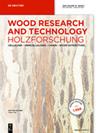温度对中国杉木动态润湿性的影响:表面铺展、渗透和蒸发的综合考虑
IF 1.6
3区 农林科学
Q2 FORESTRY
引用次数: 0
摘要
木材润湿性是液体与木材表面相互作用的过程,受木材表面化学、结构、环境条件和温度的影响。了解温度对木材润湿性的影响对于高温制造工艺至关重要。在这项研究中,我们采用了无梗液滴法来探索中国杉木在不同温度(25、40、60 和 80 °C)下使用三种不同液体(水、甘油和聚醋酸乙烯酯 (PVAc))时的动态润湿性。通过考虑铺展、渗透和蒸发,我们发现杉木的动态润湿性与温度和液体类型密切相关。温度升高会增强润湿性,导致接触角减小,渗透比增大。水的润湿性最高,其次是甘油,而 PVAc 的润湿性最低。值得注意的是,在 80 °C 下润湿 180 秒后,测得的接触角分别为:水 0°、甘油 45°、PVAc 120°。考虑到蒸发因素,水的渗透率从 57% 降至 47%(25 °C),100% 降至 62%(80 °C)。水和 PVAc 渗入杉木的活化能也有变化,分别为 35.3 和 158.3 kJ/mol。这些全面的润湿结果涵盖了铺展、渗透和蒸发,为木材-水和木材-粘合剂之间的相互作用提供了宝贵的见解,尤其是在暴露于高温条件下时。本文章由计算机程序翻译,如有差异,请以英文原文为准。
Effect of temperature on the dynamic wettability of Chinese fir wood: integrative consideration of surface spreading, penetration and evaporation
Wood wettability, the process of liquid interaction with wood surfaces, is influenced by wood surface chemistry, structure, ambient conditions, and temperature. Understanding how temperature impacts wood wettability is crucial for high-temperature manufacturing processes. In this study, the sessile drop method was employed to explore the dynamic wettability of Chinese fir wood using three different liquids (water, glycerol and polyvinyl acetate (PVAc)) across a range of temperatures (25, 40, 60 and 80 °C). By considering spreading, penetration and evaporation, we revealed that the dynamic wettability of Chinese fir was strongly dependent on temperature and the type of liquid. Temperature elevation enhances wettability, leading to reduced contact angles and increased penetration ratios. Water exhibited the highest wettability, followed by glycerol, with PVAc being the least wetting agent. Notably, after 180 s of wetting at 80 °C, the measured contact angles were 0° for water, 45° for glycerol, and 120° for PVAc. When accounting for evaporation, the penetration of water decreased from 57 % to 47 % (25 °C) and 100 % to 62 % (80 °C). The activation energies for the penetration of water and PVAc into Chinese fir exhibited variations, with values of 35.3 and 158.3 kJ/mol, respectively. These comprehensive wetting results, covering spreading, penetration and evaporation, provide valuable insights into wood–water and wood–adhesive interactions, particularly when exposed to high-temperature conditions.
求助全文
通过发布文献求助,成功后即可免费获取论文全文。
去求助
来源期刊

Holzforschung
工程技术-材料科学:纸与木材
CiteScore
4.60
自引率
4.20%
发文量
83
审稿时长
3.3 months
期刊介绍:
Holzforschung is an international scholarly journal that publishes cutting-edge research on the biology, chemistry, physics and technology of wood and wood components. High quality papers about biotechnology and tree genetics are also welcome. Rated year after year as one of the top scientific journals in the category of Pulp and Paper (ISI Journal Citation Index), Holzforschung represents innovative, high quality basic and applied research. The German title reflects the journal''s origins in a long scientific tradition, but all articles are published in English to stimulate and promote cooperation between experts all over the world. Ahead-of-print publishing ensures fastest possible knowledge transfer.
 求助内容:
求助内容: 应助结果提醒方式:
应助结果提醒方式:


